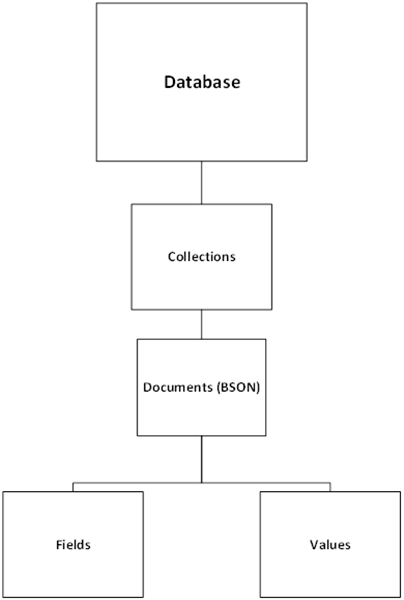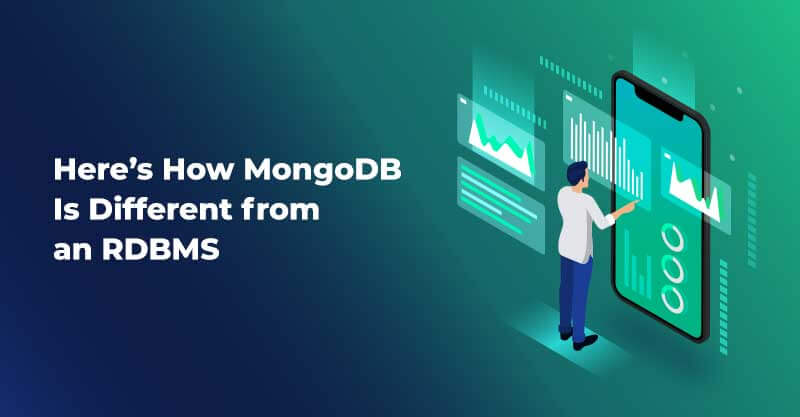Here’s How MongoDB Is Different from an RDBMS

Written by Hafsa Mustafa
Content Writer
October 3, 2022
MongoDB is a NoSQL database that stores data in document form. It uses a language of its own, called BSON, for the purpose, which is quite similar to JSON in character. It also uses collections instead of tables and documents instead of rows while key value pairs work as the basic units for the database. While working with MongoDB, a user can classify data according to two categories; Fields and Values.
This document-oriented database came out in 2007 and now owes its popularity to the high flexibility and scalability it provides to its users. MongoDB arranges a mega event, the MongoDB World conference, every year to educate its developers, partners, and customers regarding its practices.
Architecture & Working
As mentioned above, MongoDB incorporates Collections and Documents in its database. The stored data appears in the form of documents and nested subdocuments. For storage purposes, MongoDB database converts the JSON data into a binary format, i.e., BSON, to put it in the documents.
It keeps the data in the form of fields and values. For instance, while storing data about a particular person, for example, Mathew, the name as a category is ‘field’ whereas the name itself (i.e., Mathew) is a value. MongoDB supports multiple programming languages like C++, PHP, Python, Ruby, Scala, etc.

Distinguishing Characteristics of MongoDB
Significant characteristics of the MongoDB Database are given below:
Flexible Schema
While working with MongoDB, there is no need to formulate schemas before you start pouring in data. Schemas or fields can be formed on the fly, i.e., while you are storing data in the database. Moreover, since MongoDB works schema-free, each document in a given collection is not required to be similar.
High Scalability
MongoDB supports both read and write scalability. It ensures data accessibility and load sharing horizontally as well as vertically. MongoDB is highly scalable because it doesn’t follow a relational model for data storage. It allows one to connect multiple functioning nodes within a cluster. This enables the data to get distributed across the network.
Load Balancing
MongoDB employs the principle of sharding to balance the load. Sharding refers to the process of splitting data sets to make them available for multiple servers. MongoDB also uses duplication to ensure increased data accessibility.
Multiple Purpose Database
MongoDB is a General-Purpose Database. It means that it does not limit itself to the structure of any specific data. The data can be of any format. Therefore, it can be said that MongoDB can handle a large variety of data efficiently. It can also easily be modified to meet multiple purposes.
Embedded Data Model
The embedded data model of MongoDB lets the users embed new data into the relevant document structure. This helps MongoDB record the relationship between different data sets and also allows users to collect and modify data in a single database.
Represents Complex Hierarchical Relationships
MongoDB permits its users to form subdocuments within the main documents. In this way, it represents the complex hierarchical relationships between different data set explicitly.
Flexible Query
MongoDB has a flexible query model. One can easily index different parts of a document to retrieve them later through querying by field. This feature significantly improves the performance of searches within MongoDB and enables the users to go to the fields of their interest instantly within the document.
Simple Aggregation
Aggregation is the process of gathering or grouping data together. MongoDB database provides native aggregation to its users, who can readily extract, transform, and load the data in the format of their choice. They can also export the data to other platforms or sources.
MongoDB in Cloud
MongoDB Atlas is a cloud-based database that allows data management and deployment on the cloud platform, be it AWS or Google Cloud Provider. With the help of MongoDB atlas, one can scale their cluster through the cloud.
MongoDB Compass
MongoDB Compass is a Graphic User Interface that lets you interact with the content stored in the database without demanding query generation. It is an open-source database tool that enables you to visualize processes like data aggregation, exploration, and analysis. It is an effective alternative to Mongo shell.
Bug Reports
There is a mechanism to report bugs in MongoDB. Users can submit bug reports by signing into the MongoDB JIRA platform. People can also upvote the existing reports that are related to the same problem they are facing while using MongoDB.
Free Edition
MongoDB community edition is a NoSQL open-source database that complements the functioning of a cloud-based MongoDB. It is totally free and allows users to run their applications in a better manner. However, the enterprise versions of MongoDB are not free and require a license fee as well.
Conclusion
MongoDB is an ideal solution for those who are looking for non-relational database management systems. It is capable of storing and maintaining large volumes of data. MongoDB has become a widely used database in the IT community owing to the numerous benefits it provides related to application and content management.
Recent Blogs
- An Insight into ServiceNow Hardware Asset Management (HAM) Ramya Priya Balasubramanian Practice Head ServiceNow Gain …Read More »
- Learn to write effective test cases. Master best practices, templates, and tips to enhance software …Read More »
- In today’s fast-paced digital landscape, seamless data integration is crucial for businessRead More »



